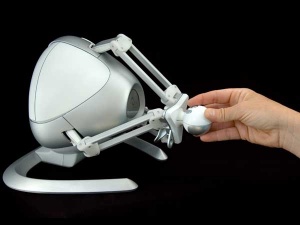Difference between revisions of "The feel of atoms"
(moved stuff as is to here from Intuitive feel) |
(No difference)
|
Revision as of 19:32, 13 August 2018
How does it feel when you grab two atoms and rub them against each other?
First I should note that trying this out for real is actually possible for quite a while now (as unbelievable as it may sound). To feel atoms you grab the end of a robot (you shake hands with it). A tiny needle with a single atom at the tip is then made to move exactly like your hand just on a lot smaller scale. When the topmost atom on the needle tip starts to touch an atom on a surface the robot arm pushes back just as the surface pushes back on the needle albeit with a magnified force big enough for you to conveniently feel it. This is called force feedback (commonly known from car racing games).
Two analogies that might convey what it feels like best are:
- rubbing soft slippery fish or water soaked gummy bears against each other
- moving two magnets past each other in repulsive (but sometimes also attractive) configuration
Moving the robot arm in and outward you can check out softness and moving sideward you can check out slipperiness.
Slipperiness
Atoms are ridiculously slippery. Like the moon orbiting the earth there's basically no friction. If certain conditions are met this low friction can be retained for larger contact areas than just the single atom on the tip of our probing needle. One condition is that the atomic ripples on a touching pair of larger surfaces must not interlock like matching egg-crates. If this and a few other things are met there is extremely low friction. It is called the superlubrication phenomenon and it has enormous potential for technical usage in slide bearings of all kinds.
Softness
So how does it feel to break a single bond between two atoms? Since I can't let you pull on this robot arm over the web lets turn the robot arm facing downwards and tie an empty plastic bottle onto it in which we will later fill some water. We can also use a simple coil spring instead of the robot arm giving force feedback
For realism we can make the robot arm behave exactly as stiff as the bond between two atoms. Caution! Please do not mistake stiffness with force. Stiffness is how much the force grows per the length you pull. A bond between two atoms obviously has only a tiny force but this force builds up on a tiny distance. Thus while the robot arm needs to magnify both force and length the stiffness of the bond turns out to be in the right size such that the robot arm can simulate it 1:1.
Now here's a quiz: Assuming you fill half a liter of water into the plastic bottle how much will the robot arm simulating the stiffness of a bond between two carbon atoms in diamond give (very roughly)
A:~1mm ☐ B:~1cm ☐ C:~1dm ☐
Hidden solution:
- A bond between two carbon atoms in (C-C bond) in diamond has a (maximum) spring constant of: k = 440N/m =~ 450g/cm.
Thus half a liter of water which makes 500g bends the setup ~1cm so the answer is B:~1cm ☒. That feels pretty soft to the hand. - halving the size -> halves the stiffness ... this is an instance of a scaling law of whom you'll here a lot here
- Just remember: The smaller things are the floppier they become. Even diamond one of the strongest materials in existence feels pretty soft at the scale of single atomic bonds.
